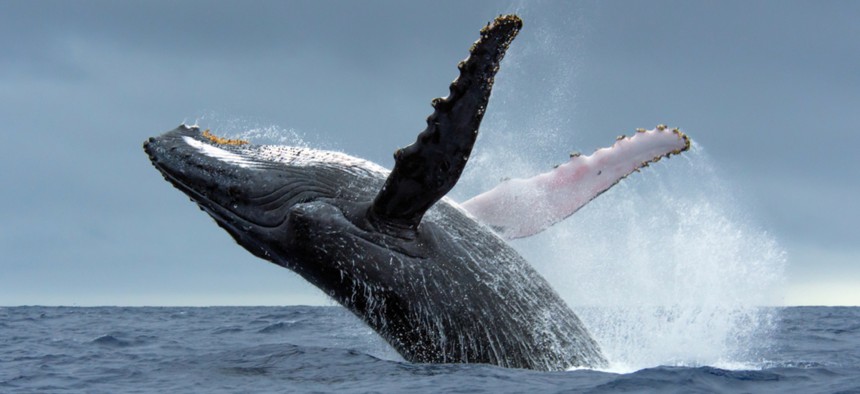Drones Let Scientists Get Inside Humpback Whale Blowholes

Tomas Kotouc/Shutterstock.com
These flying drones, got much closer to these whales than humans typically can.
Whales are notoriously hard to study. Scientists can sometimes observe the animals from boats or scuba dives, but whales tend to be suspicious of foreign ocean visitors and swim away if they feel threatened.
Flying drones, though, can get much closer to whales than humans typically can. A team of marine biologists led by the Woods Hole Oceanographic Institution in Massachusetts and the National Oceanic and Atmospheric Administration used remote-controlled hexacopters to get within a few feet of 26 different humpback whales to sample their blowhole microbiomes. These drones—custom fitted with cameras and petri dishes—flew above whales coming up for air, and collected samples of the water they exhaled out of their blowholes. The idea was to culture the microbes in the samples to get an idea of the tiny life living within these 50-foot creatures.

Whales use the blowholes atop their heads to breathe. Like our noses, these orifices are filled with living organisms. The microbes don’t disturb humans, and the makeup of a person’s microbe community can reflect the state of their health.
Marine biologists working on this project thought if they could get an idea of a healthy blowhole microbiome, they could better understand what happens to these whales when they get sick. There isn’t a lot of research on what kind of microbes infect these creatures; looking at a healthy population could help identify dangerous microbes in the future. It could also help researchers figure out when pollutants are altering healthy humpback microbiomes, and presumably other aspects of the whale’s health.
In this case, the researchers took microbial samples from humpbacks off Cape Cod in the northern Atlantic Ocean, and off Vancouver Island in the Pacific Ocean. The results, published Oct. 10 in the journal mSystems, showed 25 species of microbes that appeared in every sample.
Researchers have no idea how these microbes impact whale health just yet. They were only looking at a small sample of whales, and populations of different bacteria have only been linked to general health. That said, 20 of the 25 microbial species discovered in the whales also tend to show up in other marine mammal microbiomes, which suggests that they’re somehow crucial to marine mammal respiratory health, according to the study.
Follow up work may be able to give researchers more insight as to how these microbes may cause or prevent disease. Humpback whales are no longer listed as endangered species, but scientists at NOAA are still concerned about them. In the past two years, over 50 have washed up dead on the eastern coast of the US, which the group refers to as an “unusual mortality event.”





